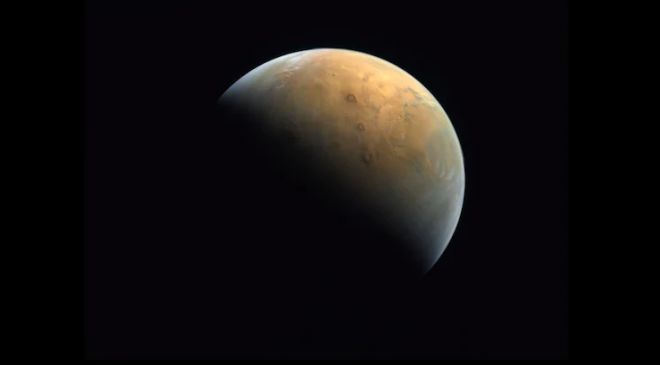Scientists at the Physical Research Laboratory in Ahmedabad have spotted thousands of tracks on the surface created by tumbling boulders.
The images of tracks left behind by Curiosity and the Perseverance rover on Mars are reminders of human ingenuity on another planet that has remained untouched for millenniums. However, the two rovers are not the only things leaving their marks on this uninhabitable world, there are natural forces at work as well.
Scientists at the Physical Research Laboratory in Ahmedabad have spotted thousands of tracks on the surface created by tumbling boulders. These boulder tracks can be used to pinpoint recent seismic activity on the planet as humans become more and more interested in the Red Planet with plans to develop colonies in the near future.
“Mars is currently active,” says Dr S Vijayan, Assistant Professor with the Planetary Science Division at the Physical Research Laboratory, who led the research.
The study published last month in Geophysical Research Letters states that it takes about two to four Martian years (four to eight Earth years) for these boulder tracks to disappear, whereas on Earth they are rarely preserved. These ejections and tracks can be used to recognise very recent surface processes on planetary surfaces.
When a boulder falls, at each bounce the regolith (Martian surface material) on the surface is thrown out in a unique pattern. On Mars, these patterns appear V-shaped, with the spread pointing downslope and the spacing between each bounce is non-uniform. The spatial spread of BFE varies from bounce-to-bounce and boulder-to-boulder.

The herringbone-like patterns of tracks on the surface are formed by the bouncing of boulders, and 4,500 such tracks have been spotted in the nearly 900-kilometre length of the surface. Nearly 30 per cent of these ejections are observed in the Cerberus Fossae region, which suggests it is one of the most seismically active regions on Mars.
Led by Vijayan, the researchers glanced over thousands of images captured from 2006 through 2020 by the High-Resolution Imaging Science Experiment (HiRISE) camera onboard Nasa’s Mars Reconnaissance Orbiter. They found unique tracks all over indicating recent activity on the planet.
MARS IS ACTIVE
Speaking to IndiaToday.in, Dr Vijayan said that most of these tracks that they have spotted are likely just a few decades old, some even younger than that. “These tracks take a few years to disappear, which indicate that the ones we have spotted are fairly new.”
“Identification of BFE in Mars and other planetary/satellite bodies is an important piece of direct evidence for recent boulder falls within the last few decades and is a good indicator for geologically active regions,” he added.
The team also spotted the tracks branching off midway indicating the integration of the boulders into newer chunks.
When it comes to geological activity, scientists last year confirmed that the planet’s centre is molten, likely having a similar composition as Earth, which has a molten outer core and a solid inner core. Seismic waves are key to understanding the deep layers of Martian composition. As waves move varying in speed and shape while travelling through different materials inside a planet, they provide seismologists with a way to study the Red Planet’s inner structure.
The new research further adds to the intrigue of geological activity on the Red Planet, making it crucial to understand, as more and more resources are poured towards our planetary neighbour with plans to build a future settlement.





































